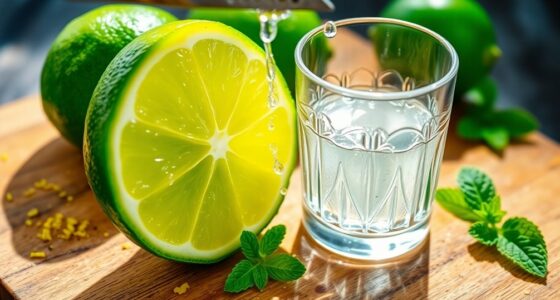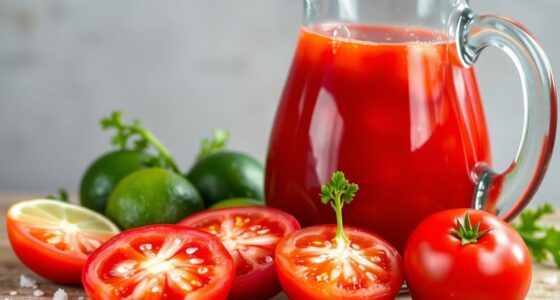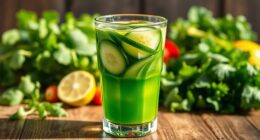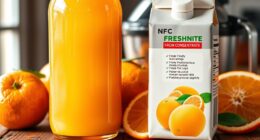Once you’ve opened juice, it usually lasts between 7 to 10 days in the fridge for store-bought options, while freshly squeezed juice should be consumed within 2 to 3 days. To keep your juice fresh, store it in an airtight container and minimize how often you open it. Always check for signs of spoilage like off odors or discoloration. If you’re curious about maximizing your juice’s freshness and storage tips, there’s more to explore! It’s also important to note that certain juices, such as lemon juice, can last longer due to their acidity. If you’re wondering how to store opened lemon juice, keeping it in the refrigerator in a tightly sealed container can extend its freshness for up to a month. Additionally, consider using ice cube trays to freeze lemon juice in small portions, allowing you to use it whenever you need it without compromising its quality.
Key Takeaways
- Store-bought juice lasts 7 to 10 days in the refrigerator after opening.
- Freshly squeezed juice is best consumed within 2 to 3 days after opening.
- Unopened shelf-stable juice can last 6 to 12 months, but must be consumed within 7 to 10 days once opened.
- Signs of spoilage include off odors, discoloration, and mold; discard if present.
- Use an airtight container and minimize exposure to air to extend juice freshness.

When you crack open a bottle of juice, you might wonder how long it'll stay fresh in your fridge. Juice is a delicious and refreshing drink, but once you've opened it, its freshness can quickly diminish. The shelf life of opened store-bought juice typically lasts between 7 to 10 days in the refrigerator. However, this can vary depending on the type of juice and how you store it. If you're enjoying a bottle of refrigerated juice, it's essential to keep it in an airtight container after opening to maintain its quality.
If you've opted for freshly squeezed juice, you'll want to be especially mindful of its shelf life. Freshly squeezed juice is best consumed within 2 to 3 days after opening. Unlike store-bought varieties, freshly squeezed juice lacks preservatives, making it more susceptible to spoilage. Therefore, if you're planning to enjoy it, try to consume it as soon as possible for the best quality and taste.
When it comes to unopened shelf-stable juice, it can last anywhere from 6 to 12 months without any issues. However, once you open that bottle, the clock starts ticking. You should aim to consume it within a week to ten days. Keeping it in the fridge is key, as the cooler temperature helps slow down the spoilage process.
Just remember, regardless of the type of juice you have, always store it properly to maximize its freshness.
As you enjoy your juice, be on the lookout for signs of spoilage. If you notice off odors, discoloration, or mold, it's best to discard the juice immediately. These signs indicate that it's no longer safe to drink, even if you haven't hit the typical timeframe for spoilage. Trust your senses; they're often your best guide.
To make your juice last longer, consider transferring it into a clean, airtight container if it isn't already. This simple step helps keep out air and bacteria, which can lead to spoilage.
Also, try to minimize how often you open and close the container, as introducing new air can affect the juice's freshness.
Frequently Asked Questions
Can I Drink Juice 2 Weeks After Opening It?
Drinking juice two weeks after opening isn't a good idea. By that time, it's likely spoiled and could make you sick.
Check for signs like mold, an off smell, or a strange taste—if you notice any, toss it out.
Store-bought juices usually last 7 to 10 days in the fridge, while freshly squeezed ones should be consumed within a few days.
Always prioritize your health and safety!
How Long Does an Open Bottle of Juice Last?
Think of an open bottle of juice as a delicate flower; it needs care to thrive.
Generally, you'll find that an opened bottle lasts about 7 to 10 days in the fridge, depending on the juice type. Freshly squeezed juice is shorter-lived, only 2 to 3 days.
If you notice off odors or a change in color, it's time to toss it.
Keep it sealed tightly and chilled to enjoy its vibrant taste longer!
How Long Does Fresh Juice Last Once Opened?
Fresh juice lasts about 2 to 3 days in your refrigerator after you open it.
To keep it fresh, store it in airtight and opaque containers. Always check for signs of spoilage like off smells, color changes, bubbles, or mold before you drink it.
For the best flavor and nutritional value, try to consume it right away. Remember, freshly squeezed juice has a shorter shelf life than store-bought varieties.
How to Tell if Juice Has Gone Bad?
Imagine a vibrant sunrise, yet your juice now has a sour scent like a fading day.
To tell if it's gone bad, check for off odors or a change in color; dark, cloudy hues signal spoilage.
Look for bubbles or a bloated carton—those signs scream fermentation.
If you spot mold, it's time to toss it.
Finally, if the taste turns sour or unusual, don't risk it; discard the juice to stay safe.
Conclusion
So, you've opened that juice carton, and now you're counting the days until it spoils, right? Ironically, while it seems like a simple drink, its lifespan can remind us to savor what we have before it goes bad. Most juices last about a week in the fridge, but it's a lesson in appreciating freshness. So, next time you pour a glass, remember: just like life, some things are best enjoyed before they expire. Cheers!
Cindy thoroughly researches juicing trends, techniques, and recipes to provide readers with practical advice and inspiration. Her writing style is accessible, engaging, and designed to make complex concepts easy to understand. Cindy’s dedication to promoting the advantages of juicing shines through her work, empowering readers to make positive changes in their lives through the simple act of juicing.











